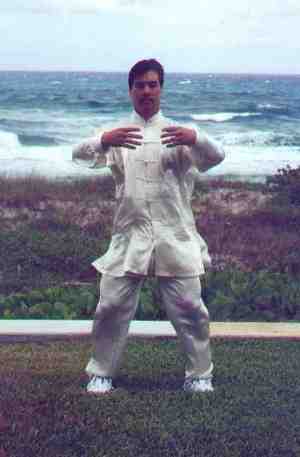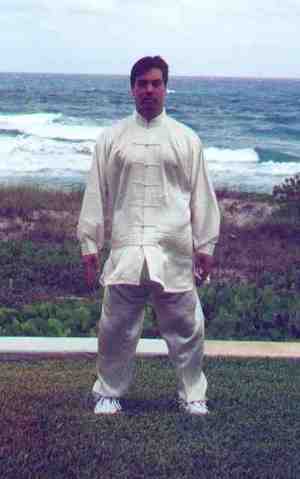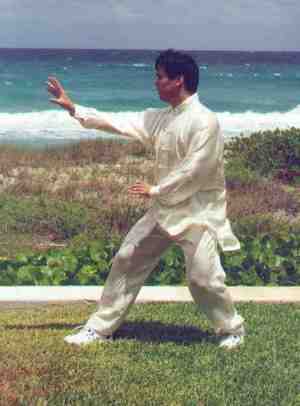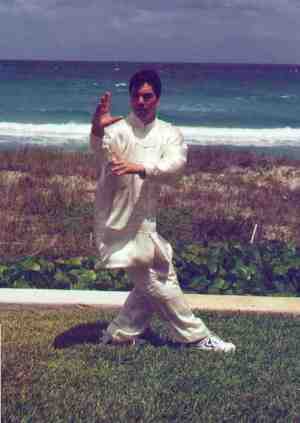Physical
Training
June 2001
Standing
Like a Stake: Internal Pathway to Power
by Michael W. Jones*
Unlike hard style martial
arts (e.g., karate, taekwondo, etc.) with which most Westerners are familiar,
traditional Chinese internal martial arts practice often involves holding
various static standing postures (zhan zhuang) for varying lengths
of time to help achieve mind-body integration by calming the mind to enable
one to consciously mold optimal structural alignment in the body itself
which can lead to more efficient movement generally. Although external
styles may also practice holding stances, internal styles take a different
approach.
 Internal
zhan
zhuang (standing post) practice is about more than merely developing
powerful legs and strong body structure, goals shared by external stance
training. Although both internal and external stance training may develop
a strong "root," internal standing practice specifically uses the mind-intent
(yi) to lead the qi/ki to develop relaxed body alignments
which are both mechanically optimally efficient and nimbly sensitive and
capable of instantaneous change in relation to one’s opponent(s). Consequently,
internal martial arts stance training does not seek to "lock" structural
body alignments in place by tensing one’s muscles (and gritting one’s teeth,
metaphorically speaking). However, this is not to say that proper internal
standing practice is not physically (as well as mentally) demanding.
Internal
zhan
zhuang (standing post) practice is about more than merely developing
powerful legs and strong body structure, goals shared by external stance
training. Although both internal and external stance training may develop
a strong "root," internal standing practice specifically uses the mind-intent
(yi) to lead the qi/ki to develop relaxed body alignments
which are both mechanically optimally efficient and nimbly sensitive and
capable of instantaneous change in relation to one’s opponent(s). Consequently,
internal martial arts stance training does not seek to "lock" structural
body alignments in place by tensing one’s muscles (and gritting one’s teeth,
metaphorically speaking). However, this is not to say that proper internal
standing practice is not physically (as well as mentally) demanding.
In a simple example of the
basic mechanics which underlie proper standing, imagine pushing on a stick
which is propped against the ground. The stick does not need to "push back"
to neutralize your push, it merely needs to conduct your force into the
ground. Next, consider two sticks placed end to end and secured with duct
tape, with the end of one stick again stuck in the ground and the free
end of the second stick up in the air at a 45 degree angle. If the alignment
of these two sticks is optimal, the force of an outside push will be conducted
through both sticks into the ground, notwithstanding the flexible "joint"
where the two sticks are duct-taped together. Once again, the structure
does not require "local muscle" to efficiently conduct force.
 The human body is analogous to this simple example, though obviously the
human endoskeleton is a much more complex structure than the simple two
stick example. Even so, the basic idea that optimal alignment(s) can efficiently
conduct force without the need for "local muscle" remains applicable. With
the addition of multiple "joints" the human body structure is capable of
efficiently conducting a wide variety of different force vectors into the
ground while evenly distributing and minimizing the stresses along the
force path through the body by balancing the relative angles of the joints.
Excess muscular tension in the body structure inhibits the unimpeded pure
conduction of force through the body and makes it difficult as a practical
matter to be sensitive to and aware of the postural micro-adjustments that
must be made to optimize one's body alignments to conduct a particular
force through the body structure.
The human body is analogous to this simple example, though obviously the
human endoskeleton is a much more complex structure than the simple two
stick example. Even so, the basic idea that optimal alignment(s) can efficiently
conduct force without the need for "local muscle" remains applicable. With
the addition of multiple "joints" the human body structure is capable of
efficiently conducting a wide variety of different force vectors into the
ground while evenly distributing and minimizing the stresses along the
force path through the body by balancing the relative angles of the joints.
Excess muscular tension in the body structure inhibits the unimpeded pure
conduction of force through the body and makes it difficult as a practical
matter to be sensitive to and aware of the postural micro-adjustments that
must be made to optimize one's body alignments to conduct a particular
force through the body structure.
Many neijia practitioners
begin standing in a high neutral posture known as Wuji, a relaxed
and natural posture with feet parallel shoulder-width apart and arms hanging
down at the sides (seen at right). However, unlike "normal" standing, it
is important that one follow the classical admonitions for standing practice,
including: keep the head upright (raise the baihui, crown of head)
and the body straight; eyes gaze forward and level; hollow the chest and
raise the back (careful, this does not mean "hunch"); relax the waist and
huiyin (perineum); sink the shoulders and elbows; extend the fingers;
keep the kua (inguinal crease) open and the dang (crotch)
rounded; the tail-bone hangs straight down; keep weight balanced over yongquan
(bubbling well points behind each ball of the foot); while qi circulates
freely and completely throughout the body. Another standard variation (the
so-called "Universal Post" posture shown above left) has the arms raised
at varying heights from the lower abdomen to the shoulder level as if hugging
a tree. This helps to develop optimal alignments extending from the torso
into the arms.
 Casual
observers will likely miss the subtleties of what such practitioners are
trying to achieve by "merely" standing in an upright posture. Interestingly,
Wang Xiang Zhai’s art of Yi Quan, developed from his intensive
training in Xingyi, makes a detailed study training a variety of
different standing postures. However, one does not necessarily have to
assume a low stance to develop leg strength (as well as the overall benefits
of optimal alignment). A top level Chen style Taiji teacher such
as Chen Xiao Wang can optimally adjust one’s body alignment to make
most folks "feel the burn" even in a high standing posture like Universal
Post.
Casual
observers will likely miss the subtleties of what such practitioners are
trying to achieve by "merely" standing in an upright posture. Interestingly,
Wang Xiang Zhai’s art of Yi Quan, developed from his intensive
training in Xingyi, makes a detailed study training a variety of
different standing postures. However, one does not necessarily have to
assume a low stance to develop leg strength (as well as the overall benefits
of optimal alignment). A top level Chen style Taiji teacher such
as Chen Xiao Wang can optimally adjust one’s body alignment to make
most folks "feel the burn" even in a high standing posture like Universal
Post.
Although Universal Post standing
may be practiced generally by Taiji, Xingyi and Bagua stylists,
Xingyi
training traditionally focuses on a specific standing posture known as
San
Ti Shi (3 body posture). Santi is actually the concluding position
for the basic Metal Element technique, Pi Quan (splitting fist),
with one foot ahead of the other, front hand at head level facing palm
down aligned with lead foot, rear hand palm down in front of the dantian
(the area just below the navel), weight distribution varying depending
on style from 50-50 to a more rear-weighted posture. A fairly typical variation
of Santi standing is shown at left.
 Aikido
practitioners who are interested in this type of training can easily utilize
a basic variation of the static hanmi ready position with hands
raised to the front as if holding a sword to try to build optimal body
alignments in a static position. For those who use the ki visualization
method, one should consciously "extend ki" up from the ground and
out through the fingertips in this position. A person pressing lightly
into one's stance ought to feel the relaxed solidity of a body efficiently
grounding incoming force without relying on tensing local muscle.
Aikido
practitioners who are interested in this type of training can easily utilize
a basic variation of the static hanmi ready position with hands
raised to the front as if holding a sword to try to build optimal body
alignments in a static position. For those who use the ki visualization
method, one should consciously "extend ki" up from the ground and
out through the fingertips in this position. A person pressing lightly
into one's stance ought to feel the relaxed solidity of a body efficiently
grounding incoming force without relying on tensing local muscle.
Although Bagua stylists
often bypass extensive static standing practices to build optimal body
alignments in motion from the common practice of "walking the circle,"
some practitioners may spend some time preliminarily holding various postures
to develop static optimal body alignments. An example of a commonly held
Cheng style Bagua circle-walking posture is shown at right. When
progressing to hold this position dynamically while walking the circle,
one gains the double benefit of working on optimal body alignments in motion.
Any position that is held on one side, can also be held on the other for
balance.
Although there may be a tendency
for some to focus on how long one can hold a particular position, the amount
of time spent standing is less important than the quality of one’s practice.
There is an important distinction between an optimal efficient relaxed
body alignment that permits one to change position nimbly in relation to
outside forces and merely tensing muscles and resisting. Beginners being
adjusted for the first time by a high level teacher may find it difficult
to stand for even less than a minute in a relatively high position without
breaking the alignment. With regular practice, one gradually is able to
stand for longer periods of time. Famous masters supposedly were able to
stand in the same position for an hour or longer. Correct zhan zhuang
practice can be extremely helpful toward developing relaxed optimal body
alignments, a necessary prerequisite to developing explosive internal power
releases (fajin).
*Michael W. Jones
is the editor of the Internal
Martial Arts journal published by Six Harmonies Press,
a bimonthly print publication that provides modern coverage of traditional
Taiji, Xingyi, Bagua, Aikido and related arts with an emphasis on
practical training advice. The following article was expanded and adapted
from a Beginners' Guide article featured in the December
2000 issue of Internal Martial Arts.
 Internal
zhan
zhuang (standing post) practice is about more than merely developing
powerful legs and strong body structure, goals shared by external stance
training. Although both internal and external stance training may develop
a strong "root," internal standing practice specifically uses the mind-intent
(yi) to lead the qi/ki to develop relaxed body alignments
which are both mechanically optimally efficient and nimbly sensitive and
capable of instantaneous change in relation to one’s opponent(s). Consequently,
internal martial arts stance training does not seek to "lock" structural
body alignments in place by tensing one’s muscles (and gritting one’s teeth,
metaphorically speaking). However, this is not to say that proper internal
standing practice is not physically (as well as mentally) demanding.
Internal
zhan
zhuang (standing post) practice is about more than merely developing
powerful legs and strong body structure, goals shared by external stance
training. Although both internal and external stance training may develop
a strong "root," internal standing practice specifically uses the mind-intent
(yi) to lead the qi/ki to develop relaxed body alignments
which are both mechanically optimally efficient and nimbly sensitive and
capable of instantaneous change in relation to one’s opponent(s). Consequently,
internal martial arts stance training does not seek to "lock" structural
body alignments in place by tensing one’s muscles (and gritting one’s teeth,
metaphorically speaking). However, this is not to say that proper internal
standing practice is not physically (as well as mentally) demanding.
 The human body is analogous to this simple example, though obviously the
human endoskeleton is a much more complex structure than the simple two
stick example. Even so, the basic idea that optimal alignment(s) can efficiently
conduct force without the need for "local muscle" remains applicable. With
the addition of multiple "joints" the human body structure is capable of
efficiently conducting a wide variety of different force vectors into the
ground while evenly distributing and minimizing the stresses along the
force path through the body by balancing the relative angles of the joints.
Excess muscular tension in the body structure inhibits the unimpeded pure
conduction of force through the body and makes it difficult as a practical
matter to be sensitive to and aware of the postural micro-adjustments that
must be made to optimize one's body alignments to conduct a particular
force through the body structure.
The human body is analogous to this simple example, though obviously the
human endoskeleton is a much more complex structure than the simple two
stick example. Even so, the basic idea that optimal alignment(s) can efficiently
conduct force without the need for "local muscle" remains applicable. With
the addition of multiple "joints" the human body structure is capable of
efficiently conducting a wide variety of different force vectors into the
ground while evenly distributing and minimizing the stresses along the
force path through the body by balancing the relative angles of the joints.
Excess muscular tension in the body structure inhibits the unimpeded pure
conduction of force through the body and makes it difficult as a practical
matter to be sensitive to and aware of the postural micro-adjustments that
must be made to optimize one's body alignments to conduct a particular
force through the body structure.
 Casual
observers will likely miss the subtleties of what such practitioners are
trying to achieve by "merely" standing in an upright posture. Interestingly,
Wang Xiang Zhai’s art of Yi Quan, developed from his intensive
training in Xingyi, makes a detailed study training a variety of
different standing postures. However, one does not necessarily have to
assume a low stance to develop leg strength (as well as the overall benefits
of optimal alignment). A top level Chen style Taiji teacher such
as Chen Xiao Wang can optimally adjust one’s body alignment to make
most folks "feel the burn" even in a high standing posture like Universal
Post.
Casual
observers will likely miss the subtleties of what such practitioners are
trying to achieve by "merely" standing in an upright posture. Interestingly,
Wang Xiang Zhai’s art of Yi Quan, developed from his intensive
training in Xingyi, makes a detailed study training a variety of
different standing postures. However, one does not necessarily have to
assume a low stance to develop leg strength (as well as the overall benefits
of optimal alignment). A top level Chen style Taiji teacher such
as Chen Xiao Wang can optimally adjust one’s body alignment to make
most folks "feel the burn" even in a high standing posture like Universal
Post.
 Aikido
practitioners who are interested in this type of training can easily utilize
a basic variation of the static hanmi ready position with hands
raised to the front as if holding a sword to try to build optimal body
alignments in a static position. For those who use the ki visualization
method, one should consciously "extend ki" up from the ground and
out through the fingertips in this position. A person pressing lightly
into one's stance ought to feel the relaxed solidity of a body efficiently
grounding incoming force without relying on tensing local muscle.
Aikido
practitioners who are interested in this type of training can easily utilize
a basic variation of the static hanmi ready position with hands
raised to the front as if holding a sword to try to build optimal body
alignments in a static position. For those who use the ki visualization
method, one should consciously "extend ki" up from the ground and
out through the fingertips in this position. A person pressing lightly
into one's stance ought to feel the relaxed solidity of a body efficiently
grounding incoming force without relying on tensing local muscle.